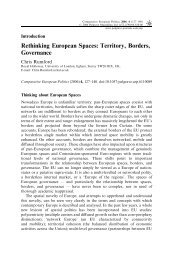Europeanisation, National Identities and Migration ... - europeanization
Europeanisation, National Identities and Migration ... - europeanization
Europeanisation, National Identities and Migration ... - europeanization
You also want an ePaper? Increase the reach of your titles
YUMPU automatically turns print PDFs into web optimized ePapers that Google loves.
Introduction 3<br />
constituencies as well as sub-national challenges activated by immigration flows<br />
between Eastern <strong>and</strong> Western Europe in particular.<br />
In the sections that follow we will present the thematic axes around which this<br />
volume is organised <strong>and</strong> the theoretical debates with which they are associated. We<br />
shall also briefly underline how the contributions included in this volume address<br />
such debates <strong>and</strong> cast new light on important conceptual <strong>and</strong> sociological issues.<br />
Regarding the relationships between European <strong>and</strong> national identities <strong>and</strong><br />
boundary constructions, within the reconstruction of Europe <strong>and</strong> the expansion<br />
of the European integration project to the East, four issues are fundamental: (1) the<br />
historical processes of <strong>and</strong> current changes in state formation <strong>and</strong> nation-building<br />
in Western <strong>and</strong> Eastern Europe; (2) the impact of the European integration process<br />
<strong>and</strong> its extension to the East on states <strong>and</strong> nations in Western <strong>and</strong> Eastern Europe;<br />
(3) within this context the changing relationships between national <strong>and</strong> European<br />
identities <strong>and</strong> boundary constructions; <strong>and</strong> last but not least (4) the ‘multicultural’<br />
impact of growing international migration <strong>and</strong> immigration on the historicallyformed<br />
nations, national identities <strong>and</strong> boundary constructions in the context of<br />
European integration.<br />
State formation <strong>and</strong> nation-building in Western <strong>and</strong><br />
Eastern Europe<br />
The implosion of the Soviet communist system has enabled the restoration <strong>and</strong><br />
reconstruction of independent nation-states in Central-Eastern Europe. These<br />
processes were accompanied by political transitions to democratic regimes <strong>and</strong><br />
social transformations towards capitalist market societies. The ‘great transformation’<br />
in the post-communist societies in Central <strong>and</strong> Eastern Europe has been predominantly<br />
seen by social <strong>and</strong> political scientists as a bundle of catching-up processes<br />
of modernisation, emulating the Western European model of a modern, democratic<br />
<strong>and</strong> capitalist nation-state. To be sure, the processes of political <strong>and</strong> economic<br />
transformation in post-communist Central <strong>and</strong> Eastern Europe have displayed<br />
considerable variations (Beyme 1996; Linz <strong>and</strong> Stepan 1996). The evolution of<br />
political regimes ranges from the consolidation of liberal-constitutional democracies,<br />
to the development of mixed democratic/authoritarian structures or the reversal<br />
of authoritarian political systems. The transformation to capitalist market societies<br />
varies from relatively successful evolution to crisis-prone development <strong>and</strong><br />
continuous decline. The processes of state formation <strong>and</strong> political/legal institutionbuilding<br />
have generally been weak <strong>and</strong>, inversely, the tendency to create ethnically<br />
homogeneous nations generally strong. But despite these variations, the Western<br />
European capitalist <strong>and</strong> democratic nation-state has served as a forceful model for<br />
the Eastern European transformations. In this sense the modern nation-state has<br />
been developing, diversifying, not dying (Mann 1993) <strong>and</strong>, with it, the European<br />
structural pluralism of independent nation-states in Western as well as in postcommunist<br />
Central <strong>and</strong> Eastern Europe has been reconstituted.<br />
Under the impression of the enormous changes brought about by the implosion<br />
of the Soviet Empire, there emerged in the social <strong>and</strong> political sciences a renewed



